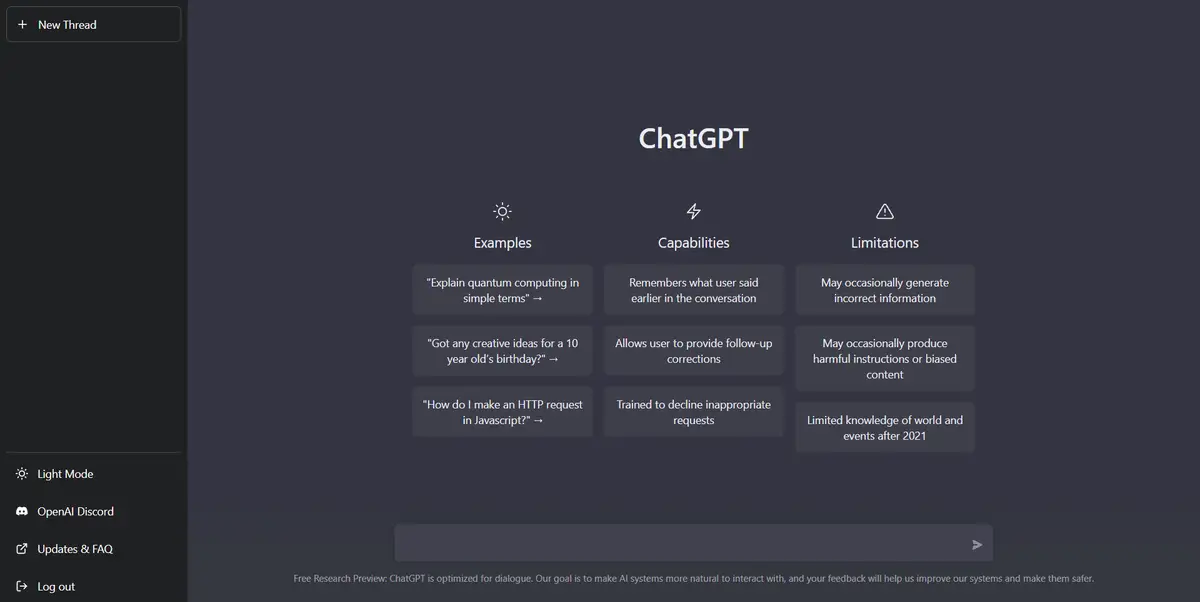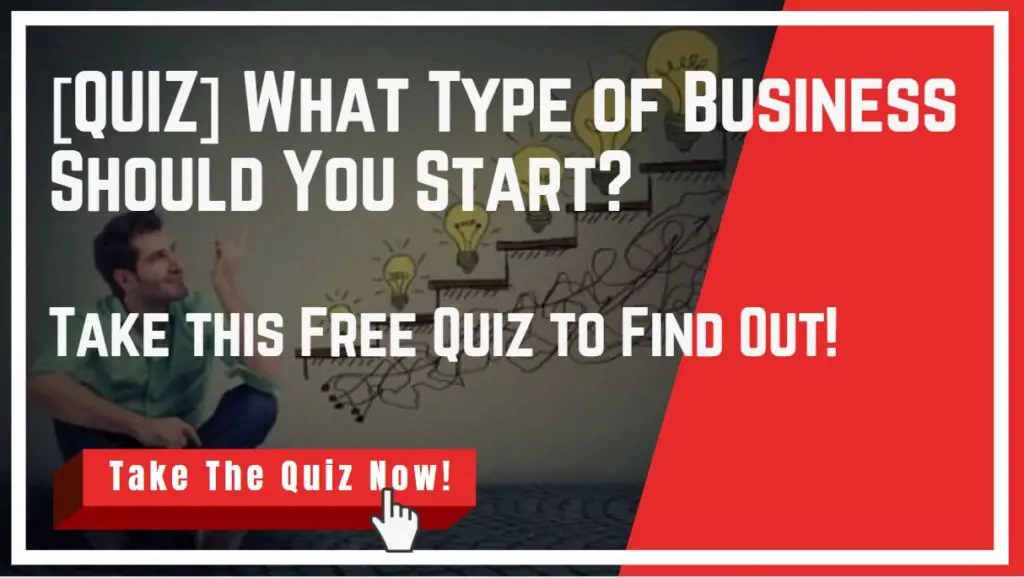ChatGPT has the potential to be a very powerful content tool that can save hours of your time and generate very high quality pieces of content.
The problem? Most people don’t know how to truly use it to its full potential.
They might see the content being generated as lackluster, nonsensical, or evident that it was created by an AI tool.
But this may not be ChatGPT’s fault…but the user’s. The quality of ChatGPT’s response is heavily predicated on the prompt it’s provided by the end user. The better the prompt, the more accurate and high-quality the response.
And that’s exactly what we are going to be tackling in this post:
Table of Contents
The Purpose of This Post
The purpose of this article is to provide a comprehensive guide to creating the perfect prompts for ChatGPT. We’ll start by exploring the basics of ChatGPT, including how it processes prompts and its limitations. From there, we’ll delve into the key factors that you should consider when crafting your prompts, including contextual information, clarity, and tone. Finally, we’ll provide a set of tips and and build out an example together help you create effective prompts that will get the best results from the tool.
Let’s get started:
What is ChatGPT?
Before we begin, let’s answer what exactly ChatGPT is.
ChatGPT is a powerful language model AI tool developed by Open.ai. It uses deep learning techniques to generate human-like responses to prompts.
At its core, ChatGPT works by analyzing the input text and generating a corresponding output based on its training data. This training data consists of billions of examples of text from a wide range of sources, including books, websites, and social media.
What Are Some Limitations Of Chatgpt?
One of the key limitations of ChatGPT is that it can only generate responses based on the information it has been trained on. This means that it may not always have the information it needs to generate an accurate or relevant response.
Another limitation is availability of recent data availability. As of the time of writing this post (early 2023), ChatGPT’s databases have data up to the end of 2021. This means that responses concerning recent events will either not generate or be false.
Additionally, ChatGPT can sometimes generate nonsensical or inappropriate responses, especially if the prompt is unclear or vague.
How Does Chatgpt Know How To Answer?
When it comes to generating responses, ChatGPT processes prompts provided by the user. It uses a combination of natural language processing (NLP) techniques and deep learning algorithms to analyze the input text and generate a response.
To get the best results from ChatGPT, it’s important to understand how it processes prompts and its limitations. With that in mind, let’s look at how we can create prompts for the perfect answer:
What to Consider When Writing Prompts for ChatGPT?
When creating prompts for ChatGPT, the best thing to remember is treating the tool as if it were another person and you were having a conversation. The more context, information, and clarity the question has, the more accurate the response.
Let’s look at some key factors that you should be taken into consideration when providing prompts to ChatGPT:
Keep prompts clear and concise:
Clarity and specificity are key to getting accurate responses from ChatGPT. When creating prompts, aim to keep them short and to the point, avoiding overly complex, or vague language.
Provide sufficient context:
Make sure to provide enough context for ChatGPT to generate a relevant response. For example, if you’re asking a question about a specific topic, provide some background information on that topic to help ChatGPT understand what you’re asking about.
Be mindful of tone and style:
The tone and style of your prompts can greatly influence the type of response generated by ChatGPT. Consider the context in which the prompt will be used, and choose a tone and style that is appropriate for that context.
Test and refine:
Sometimes the response provided might need some refining. Try different variations of the prompt, and adjust as needed based on the responses generated by ChatGPT.
By following these tips, you can help ensure that your prompts are effective and generate high-quality responses from ChatGPT. Additionally, experimenting with different types of prompts and refining your approach over time can help you get even better results from ChatGPT.
Let’s Build an Effective Prompt Together
To help illustrate the concepts discussed in previous sections, let’s build out an example and see what ChatGPT will generate. For this demonstration we will be trying to generate a marketing email for a newsletter.
Let’s break it down into 3 steps:
Step 1: The Role
Let’s give ChatGPT context by giving it a “role.”

Good start but there is simply no context, so the response will be too broad and general.

Step 2: The Action
Let’s give it purpose by giving it an “action” to follow. Here we need to be sure to provide who we want to address, the tone of voice we will be speaking in, and provide the message we want to communicate. Let’s look at an example:
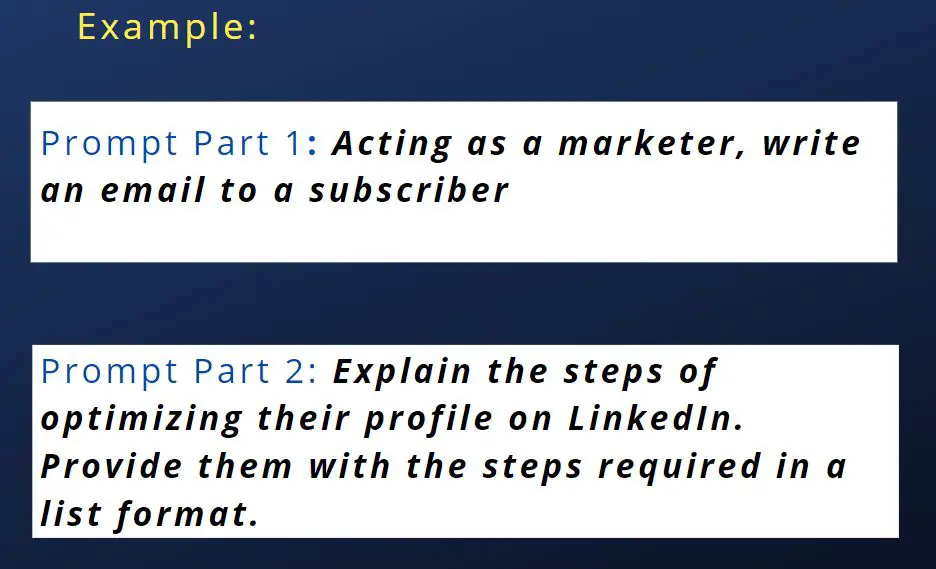
Here is what ChatGPT’s response:
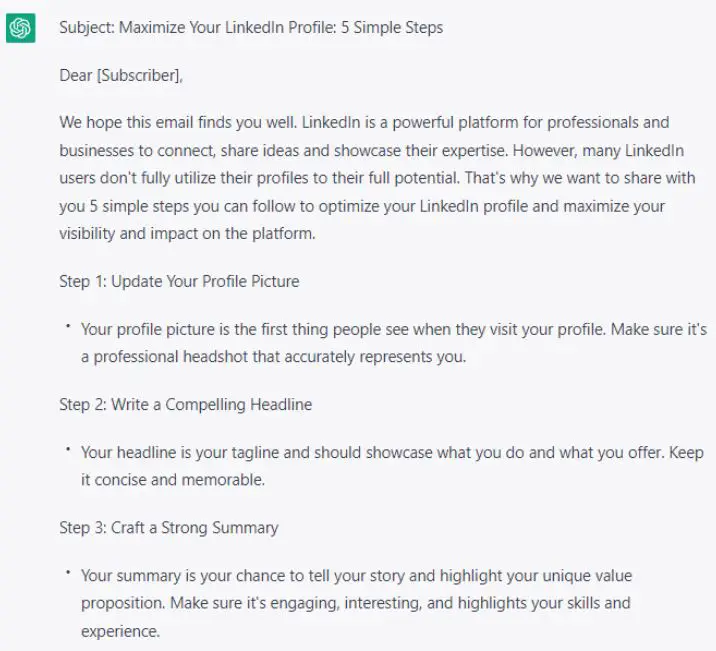
Step 3: The Details
Let’s give it an outcome by giving it key “details” to follow.
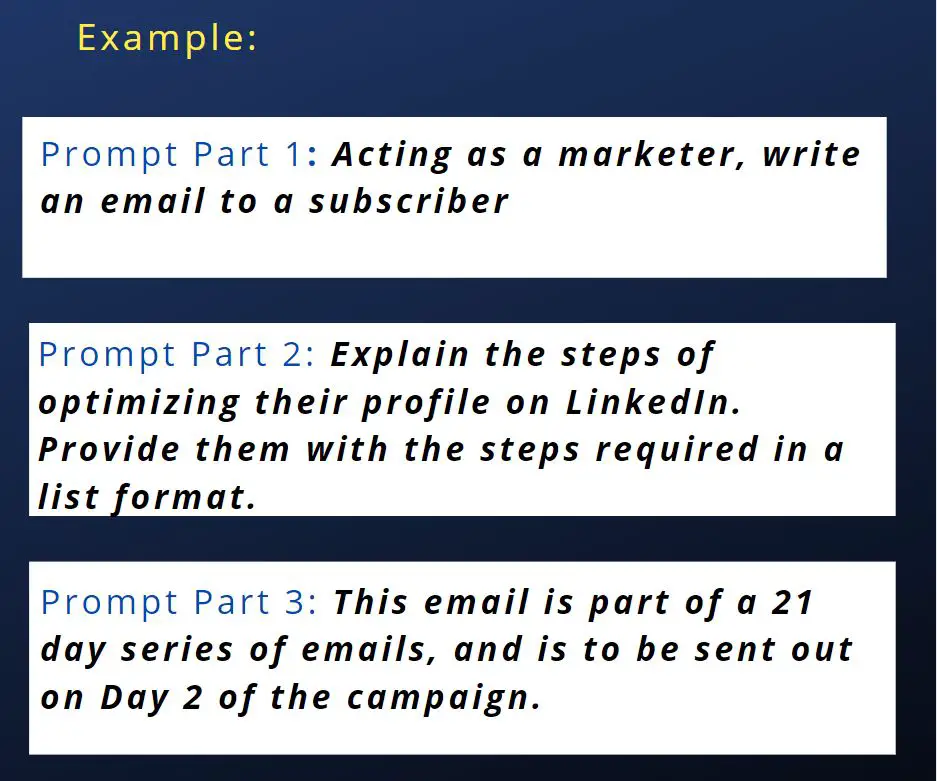
The Final prompt
Putting all the pieces together, here is our final prompt:
“Acting as a marketer, write an email to a subscriber explaining the steps of optimizing their profile on LinkedIn. Provide them with the steps required in a list format. This email is part of a 21 day series of emails, and is to be sent out on Day 2 of the campaign.”
The Final Outcome
And this is what ChatGPT responded:
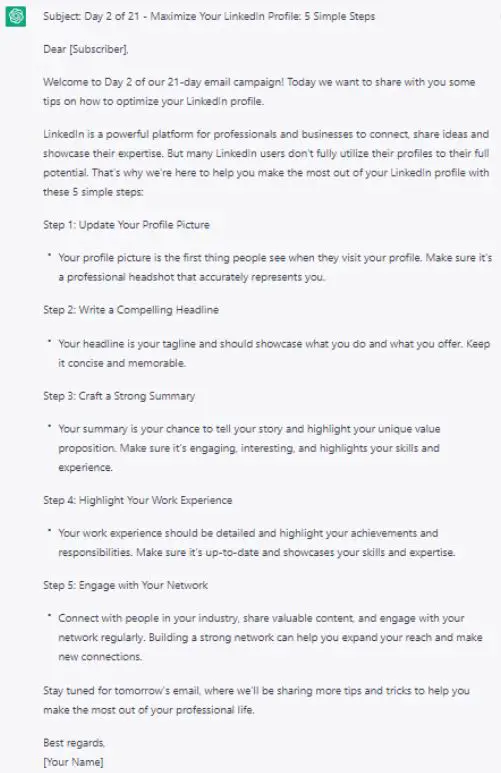
The difference between our first iteration and our last is staggering. As we provided more detail, the response became more focused, more accurate, and more valuable to the reader.
Wrapping Up
ChatGPT is a powerful language model that can generate high-quality responses to a wide range of prompts. When creating prompts for ChatGPT, it’s important to consider factors such as context, clarity and specificity, length and complexity, and tone and style.
Remember, treat it like it’s another person. The more information you provide the more focused the response.
Is there anything you would like us to cover further? Did you try the methods above? Let us know!

